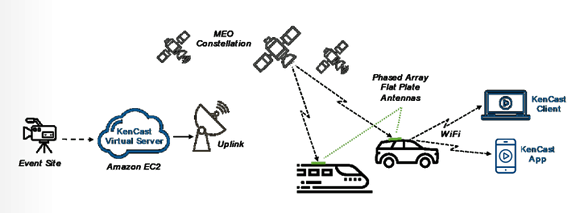
LEO and MEO satellites are going to have to deliver large files and high-resolution video streams into moving vehicles. These large files and streams will be susceptible to bad weather, inclines, and to anyone with the readily available tools to intercept the content. One company has addressed these issues ...
KenCast has begun to enable various early applications to solve these problems.
Emerging LEO and MEO constellations are poised to bring high-throughput and low-latency connectivity to moving vehicles around the world. Unlike geosynchronous (GEO) satellites, which orbit about 22,000 miles above sea level, MEO and LEO satellites orbit as close as 1,200 miles. This relative proximity to Earth dramatically reduces their cost and signal power requirements.

Delivering large files and live video streams to cars, planes, trucks, ships, trains and other vehicles on-the-move is a massive market opportunity.
To realize this potential, these constellations must master the reliable delivery to low-cost, smart, phased array antennas (a.k.a. Flat Plate Antennas, FPAs), which can be stationary or mounted on moving vehicles. FPAs are small, ultra-thin and flat, without any moving parts. Instead of aiming a physical dish, FPAs use electronic beam steering to pick up a signal.
However, early tests reveal that these beam steering, phased array antennas need to improve if they are to be fully market-ready. To be fair, the problem is extremely challenging:
- Both the transmitter and receiver are moving. For example, LEOs orbit at 17,500 mph.
- Inclines can create elevation angle issues, and tunnels will interrupt the signal altogether.
- Bad weather – especially rain clouds – can corrupt the signal.
- The satellites are small and use less power, so the signal is accordingly weaker.
Additionally, a broadcast can be captured using readily available tools. Sensitive content, then, must be secured with strong encryption (for example, 256-bit AES). But this places an even higher premium on reliability, as small errors can render encrypted content undecipherable.
KenCast's patented, innovative Forward Error Correction (FEC) software uses sophisticated algorithms to securely encode content such that it can be perfectly reconstructed by the recipient — even when the signal has suffered corruption, interruption or excessive fading.


